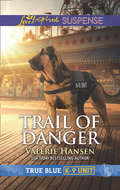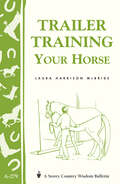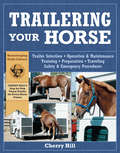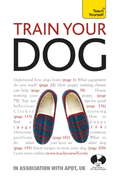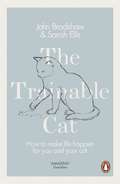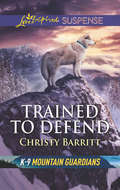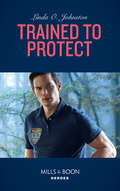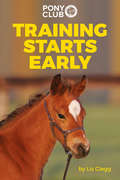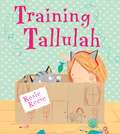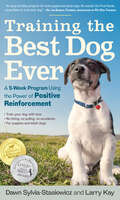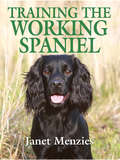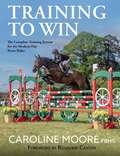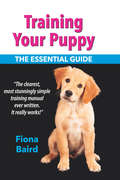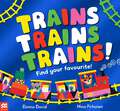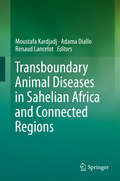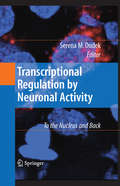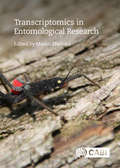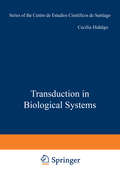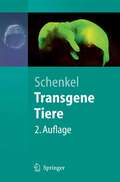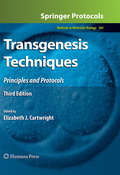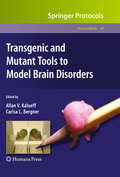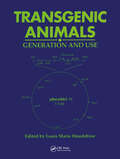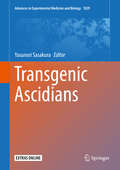- Table View
- List View
Trail Of Danger (True Blue K-9 Unit #7)
by Valerie HansenUSA TODAY Bestselling Author Valerie Hansen What she forgot could kill herA heart-stopping True Blue K-9 Unit book
Trailer-Training Your Horse: Storey's Country Wisdom Bulletin A-279 (Storey Country Wisdom Bulletin)
by Laura Harrison McBrideHow do you train a horse to get in and out of a trailer safely and calmly? With the renowned trailer-training method taught by the late Dr. Edwin Goodwin, long-time equine professor at the University of Maryland, it's simple.In Trailer Training Your Horse, journalist and equine enthusiast Laura Harrison McBride brings to publication for the first time the lessons and advice of Dr. Goodwin. The step-by-step training technique works quickly on green horses, it works fairly quickly on older horses that have already been led; and it works a bit more slowly on horse that have have negative trailering experiences. Most important, it works, almost without fail, and it can help your horse overcome fear, stubbornness, bad training, and bad handling.To accompany the training, you'll learn how to choose the right trailer, as well as how to prepare your horse for the trip and what supplies you need to make the trip as comfortable and stress-free as possible.
Trailering Your Horse: A Visual Guide to Safe Training and Traveling
by Cherry Hill Richard KlimeshProperly trailering your horse is an essential skill every horse owner needs to master. With clear text and detailed photography, Cherry Hill shows you how to choose an appropriate truck and trailer combination; train your horse to confidently enter and exit the trailer; and drive safely while pulling a loaded trailer. With tips on emergency equipment and caring for your horse en route, this guide has everything you need to know to create a safe and stress-free traveling experience for you and your horse.
Train Your Dog: Teach Yourself (Teach Yourself)
by Association of Pet Dog TrainersDo you want your dog to be socially well-behaved?Are you looking for advice on training and looking after your pet?Covering every aspect of kind, fair and effective dog training as well as authoritative advice on looking after your pet, Train Your Dog is essential reading for all dog owners or those thinking of getting a dog for the first time.Written by the APDT, a guarantee of quality in dog training, this book covers positive reward and motivational techniques that will ensure your dog is socially well-behaved, obedient and, most importantly, able to be a part of your family.It also details different training methods for different types of dog, issues to address before training commences (deciding on your commands and discovering the motivation of your dog), equipment that may aid the training experience and essential tips for training a puppy or a 'problem dog'.Packed full of essential advice on all aspects of being a dog owner, this book will ensure that you get the most out of your pet and vice versa!NOT GOT MUCH TIME?One, five and ten-minute introductions to key principles to get you started.AUTHOR INSIGHTSLots of instant help with common problems and quick tips for success, based on the author's many years of experience.TEST YOURSELFTests in the book and online to keep track of your progress.EXTEND YOUR KNOWLEDGEExtra online articles at www.teachyourself.com to give you a richer understanding of dog training.FIVE THINGS TO REMEMBERQuick refreshers to help you remember the key facts.TRY THISInnovative exercises illustrate what you've learnt and how to use it.
The Trainable Cat: How to Make Life Happier for You and Your Cat
by John Bradshaw Sarah Ellis'Amazing' GuardianFrom the on-screen experts for BBC2's Cat Watch, and based on their groundbreaking research - this is the ultimate guide to making your cat a happier, more sociable animal.The idea of a trained cat is a contradiction in terms, isn't it? Naturally solitary, wary, easily threatened by newcomers, they are attached to place rather than people, and much of their 'antisocial' behaviour arises in situations where that attachment is threatened. But, as cat experts Sarah Ellis and John Bradshaw argue, such stress-induced behaviour can be prevented, reduced, even eliminated, by training.A comprehensive and engaging step-by-step guide, The Trainable Cat will help you to help your cat negotiate the complexities of everyday life: to enjoy living with humans - including new babies and lively toddlers - and other pets; to answer to their name; settle into a new home; and to overcome the anxiety of a visit to the vet. You can train your cat to do what is in its own best interests - even when its instincts tell it otherwise. 'I doubt you'll find a more well-informed or scientific book on cats that better shows you how feline thinking works' The Times
Trained To Defend (K-9 Mountain Guardians)
by Christy Barritt“Take Buzz and run. Far away.…and don’t trust the police.”
Trained To Protect: The Pregnant Colton Witness Rancher's Deadly Reunion Soldier Bodyguard Trained To Protect (K-9 Ranch Rescue #2)
by Linda O. JohnstonA cop falls for the woman he’s sworn to protect
TRAINING STARTS EARLY: THE PONY CLUB'S GUIDE TO BACKING AND BRINGING ON YOUNG HORSES AND PONIES
by Lis Clegg'Training Starts Early' is the ideal guide for those looking to start a young horse or pony. Starting a horse is a long-term investment that takes patience and commitment, but is also fun and rewarding: you really do get out what you put in. Discipline, kindness, firmness and routine are very important, and this book will guide you through the steps and stages necessary to educate the horse in a way he understands and make allowances for his lack of experience and physical ability while he's growing and learning.
Training Tallulah
by Rosie ReeveWhen Tom met Tallulah, he was just a shy little kitten. But Tallulah knew just how to make him feel at home. Tallulah, you see, is very good at speaking CAT. She can always tell exactly what Tom wants from a simple "purr" or "meow". They are the perfect team and best friends...until Tom decides to learn HUMAN. Suddenly their relationship is turned topsy-turvy as Tom starts dressing, walking, and talking like a human...and Rosie won't stop acting like a cat! But what will happen when Tom starts wondering...what would it be like to have a dog for a pet? This rebelliously funny picture book from illustrative veteran Rosie Reeve will leave readers wondering . . . exactly how much trouble can one rascally cat get up to?
Training Tallulah
by Rosie ReeveWhen Tom met Tallulah, he was just a shy little kitten. But Tallulah knew just how to make him feel at home. Tallulah, you see, is very good at speaking CAT. She can always tell exactly what Tom wants from a simple "purr" or "meow". They are the perfect team and best friends...until Tom decides to learn HUMAN. Suddenly their relationship is turned topsy-turvy as Tom starts dressing, walking, and talking like a human...and Rosie won't stop acting like a cat! But what will happen when Tom starts wondering...what would it be like to have a dog for a pet? This rebelliously funny picture book from illustrative veteran Rosie Reeve will leave readers wondering . . . exactly how much trouble can one rascally cat get up to?
Training the Best Dog Ever: A 5-Week Program Using the Power of Positive Reinforcement
by Larry Kay Dawn Sylvia-StasiewiczTraining the Best Dog Ever, originally published in hardcover as The Love That Dog Training Program, is a book based on love and kindness. It features a program of positive reinforcement and no-fail techniques that author Dawn Sylvia-Stasiewicz used to train the White House dog, Bo Obama, and each of Senator Ted Kennedy’s dogs, among countless others.Training the Best Dog Ever relies on trust and treats, not choke collars; on bonding, not leash-yanking or reprimanding. The five-week training program takes only 10 to 20 minutes of practice a day and works both for puppies and for adult dogs that need to be trained out of bad habits. Illustrated with step-by-step photographs, the book covers hand-feeding; crate and potty training; and basic cues—sit, stay, come here—as well as more complex goals, such as bite inhibition and water safety. It shows how to avoid or correct typical behavior problems, including jumping, barking, and leash-pulling. Plus: how to make your dog comfortable in the world—a dog that knows how to behave in a vet’s office, is at ease around strangers, and more. In other words, the best dog ever.
Training the Working Spaniel
by Janet MenziesTraining the Working Spaniel makes it simple for anyone to train their gundog, no matter what facilities are available. The book contains chapters on training the urban gundog; how to keep a working dog in a family home; and introducing first-timers to working their spaniel in a variety of shooting situations. The author takes the reader, whether novice or experienced, all the way from teaching the pup to hup to competing in field trials at the highest levels. The book covers everything from the first lessons in sitting and staying, to working on live game. It then covers advanced work in the field, rough shooting, picking-up, and training as a peg dog. The final part of the book introduces the reader to elite spaniel work in field trials as well as giving guidance on breeding your own dogs. With unique access to the most successful spaniel trainers, the author brings exclusive tips from the top that can be used by any beginner.
Training Your Puppy: The Essential Guide
by Fiona BairdFollow these simple instructions and your puppy should develop into a delightful, obedient and devoted member of your family. He will bring you great companionship and happiness for many years to come. There are many puppy-training books available today, but none so clear and coherent as this one. There is a strong logic to Fiona Baird’s method which gives confidence to both owner and puppy. She makes training fun, simple and very straightforward. Fiona Baird has trained countless puppies professionally, and has many devoted clients. She truly is the Mary Poppins of puppy training.
Trains Trains Trains!: Find Your Favourite (50 to Follow and Count)
by Donna DavidBig trains, small trains, short trains, long trains . . . which do you like best? Follow fifty colourful trains as they whizz along tracks and through tunnels – up, down, around and back again! Can you find your favourite?Full of spotting and counting fun, with five trains to find on each page and an exciting fold-out race at the end, this rhyming preschool picture book from Donna David and Nina Pirhonen has been specially developed to encourage pre-reading skills and expand language and vocabulary.With a super-shiny foil cover and fun read-aloud text, Trains Trains Trains! is just the ticket for any transport-obsessed toddler!
Transboundary Animal Diseases in Sahelian Africa and Connected Regions
by Moustafa Kardjadj Adama Diallo Renaud LancelotThis book primarily focuses on the African Sahel region, shedding new light on the epidemiology, socio-economics, clinical manifestations and control approaches of transboundary animal diseases (TADs) in this specific region. In addition to the description of TADs in Sahelian Africa and connected regions, several issues regarding the burden of TADs, the role of national/regional/international veterinary organizations in the surveillance process, animal mobility, one health and TADs in the dromedary are discussed. The book contains 22 chapters and is structured in three parts, i- general features and commonalities, ii- viral diseases, iii- bacterial diseases. Each chapter was written by a group of experts specialized in the topic. This work will be of general interest to researchers, veterinarians, veterinary public health officers, and students engaged in the surveillance and control of animal infectious diseases, included those of zoonotic nature and that are prevalent in the Sahel.
Transcriptional Regulation by Neuronal Activity: To the Nucleus and Back
by Serena DudekRegulation of gene transcription by neuronal activity is evident in a large number of neuronal processes ranging from neural development and refinement of neuronal connections to learning and response to injury. In the field of activity-dependent gene expression, rapid progress is being made that can impact these, and many other areas of neuroscience. This book offers an up-to-date picture of the field.
Transcriptomics in Entomological Research
by May R Berenbaum Bernarda Calla Joanna C. Chiu Jürgen Ehlting Melanie Gee Aman Gill Martin Hasselmann Matthew Huff Brian R Johnson Juan Luis Jurat-Fuentes William E Klingeman Kyle M. Lewald Shanlin Liu Antonino Malacrinò Guanliang Meng Yoonseong Park Amber Rose Paulson Steven J Perlman Ratnasri Pothula Sampurna Sattar Margaret E Staton James P Tauber Gary A Thompson Patrick Von Aderkas Will Kipling Chengran ZhouBridging the gap between genome and phenotype, the transcriptome is a molecular-level snapshot of the act of living. Transcriptomics shows which genes are expressed into proteins in a specific tissue of a specific organism at a specific time and condition. This book gives an account of the extraordinary diversity of ways transcriptomics has been and can be utilised in basic and applied entomological research. It encompasses a vast range of disciplines within entomology, applying transcriptomics to the study of over one million described species of insects. It covers a vast range of disciplines from phylogenomics to pest management, from ecology to physiology, and from behavior to evolutionary biology. The book covers the breadth and depth of transcriptomics use in research to showcase the utility of this technology in all disciplines. Research examples in the book are relevant to fish, birds, plants, and fungi, as well as insects and other arthropods, helping scientists in any field, using any system, to understand what transcriptomics can do for them. The book: Introduces transcriptomics theory and practice for researchers of all levels wishing to gain an insight into how to apply these techniques to their own fields. Showcases the myriad ways transcriptomics can be used to answer biological questions. Is written by a team of international experts describing their own experiences, giving guidance for applying it to the reader's own work. Reviews how transcriptomics research has helped entomologists push their fields further and make new discoveries.
Transduction in Biological Systems (Series of the Centro De Estudios Científicos)
by Cecilia Hidalgo Juan Bacigalupo Enrique Jaimovich Julio VergaraThe present volume originated from the workshop "Transduction in Biological Sys tems," held at the Marine Biological Station of the Universidad de Valparaiso, Mon temar, Chile, May 23-30, 1988, and contains contributions from most of the partici pants in the workshop. The title of both the workshop and the book reflects accurately the central theme discussed during several days of intense debate and profound intellectual exchange in the peaceful environment offered by the central coast of Chile. It was apparent that the workshop was a great success-a sentiment expressed by many seasoned attendees, some of whom dared opinions as strong as "It was the best ever." There is no single reason to explain why this workshop was so successful. Certainly instrumental was the incredible effort displayed by the Chilean Organizing Committee in selecting adequate facilities and in organizing social events that supplemented the scien tific sessions and provided an authentic fraternal environment for the participants. Equally important were the foreign participants, who enthusiastically gave of their time to take part in the event, and the students, who came from Chile as well as from several other Latin American countries, and who applied the necessary pressure in their repeated demands for scientific clarity, accuracy, and sincerity.
Transgene Tiere (Springer-Lehrbuch)
by Johannes SchenkelDer Autor beschreibt anschaulich die Techniken, mit denen Gene mutiert, in Tiere eingebracht und diese Tiere gezüchtet werden können. Screening-Methoden zum Nachweis des Transgens werden ebenso ausführlich erklärt wie Zucht, Haltung und Sicherung transgener Tiere. Weitere Themen sind die Transgenese in anderen Spezies, ethische Aspekte, Sicherheitsfragen, rechtliche Voraussetzungen sowie der Tierschutz. Für die völlig überarbeitete 2. Auflage wurden u. a. die Abschnitte zu transgener Technologie sowie zu Zucht und Haltung aktualisiert bzw. ergänzt.
Transgenesis Techniques: Principles and Protocols (Methods in Molecular Biology #561)
by Elizabeth J. CartwrightOne of the major challenges currently facing the scientific community is to understand the function of the multitude of protein-coding genes that were revealed when the human genome was fully sequenced. In Transgenesis Techniques: Principles and Protocols, Third Edition, experts in the field fully update and expand upon the previous edition in order to detail the transgenic techniques currently used to modify the genome. The volume explores classic procedures to genetically modify mice and other model organisms, as well as cutting-edge practices involving microinjection, site-specific recombination systems, cryopreservation, and many other topics. Written in the highly successful Methods in Molecular Biology™ series format, the chapters include brief introductions to their subjects, lists of the necessary materials and reagents, step-by-step, readily reproducible laboratory protocols, and notes sections, highlighting tips on troubleshooting and avoiding known pitfalls. Comprehensive and state-of-the-art, Transgenesis Techniques: Principles and Protocols, Third Edition is a comprehensive practical guide to the generation of transgenic animals and an invaluable source of information in any lab currently involved in transgenic techniques.
Transgenic and Mutant Tools to Model Brain Disorders (Neuromethods #44)
by Allan V. Kalueff and Carisa L. BergnerAs the presence of genetically modified animal models in research laboratories has multiplied, the role of genetic factors in the pathogenesis of brain disorders has become particularly important. The refinement of molecular genetic methods has continued to broaden our understanding of the genetic factors associated with a variety of disorders. In "Transgenic and Mutant Tools to Model Brain Disorders", leading scientists specializing in this field contribute a timely collection of recent advances featuring a vast array of topics in order to contribute to the diverse approaches taken toward the evaluation of genetically modified models in biomedical research. Opening with several chapters covering general aspects of genetically modified animal models, the book then continues with detailed chapters on models of specific human brain disorders, including OCD, Rett Syndrome, anxiety disorders, depression, and schizophrenia. As a volume in the successful Neuromethods™ series, the chapters provide authoritative reviews covering the most commonly used approaches in the field. Cutting-edge and concise, "Transgenic and Mutant Tools to Model Brain Disorders" offers a comprehensive and descriptive overview on a variety of topics in neuroscience and biological psychiatry.
Transgenic Animals
by Louis-Marie HoudebineDuring the past 20 years, transgenesis has become a popular technique and a crucial tool for molecular geneticists and biologists. Transgene expression is now better-controlled and even specifically inducible by exogenous factors. While these techniques have quite significantly transformed the experimental approaches taken by biologists, the applications are more limited than expected and concerns have arisen regarding biosafety as well as physiological, social, and philosophical issues. Transgenic Animals: Generation and Use contains articles on the techniques used to generate transgenic animals and a section on the preparation of vectors for the optimally controlled expression of transgenes. It also examines the use of transgenic animals in the study of gene function and human diseases, the preparation of recombinant proteins and organs for pharmaceutical and medical use, and the improvement of genetic characteristics of farm animals. Finally, it discusses more recent problems generated by transgenic animals including conservation of transgenic lines, specific database patenting, biosafety, and bioethics.Drawn from both academia and industry, the contributors to this monograph present in one concise volume all the relevant information on the different aspects of transgenesis. This book can be used as both a reference book and a textbook for specialized university courses and will be of interest to everyone involved in basic research in animal biology, molecular genetics, animal biotechnology, pharmaceutical science, and medicine.
Transgenic Animals: Generation And Use
by Louis-Marie HoudebineDuring the past 20 years, transgenesis has become a popular technique and a crucial tool for molecular geneticists and biologists. Transgene expression is now better-controlled and even specifically inducible by exogenous factors. While these techniques have quite significantly transformed the experimental approaches taken by biologists, the applications are more limited than expected and concerns have arisen regarding biosafety as well as physiological, social, and philosophical issues. Transgenic Animals: Generation and Use contains articles on the techniques used to generate transgenic animals and a section on the preparation of vectors for the optimally controlled expression of transgenes. It also examines the use of transgenic animals in the study of gene function and human diseases, the preparation of recombinant proteins and organs for pharmaceutical and medical use, and the improvement of genetic characteristics of farm animals. Finally, it discusses more recent problems generated by transgenic animals including conservation of transgenic lines, specific database patenting, biosafety, and bioethics.Drawn from both academia and industry, the contributors to this monograph present in one concise volume all the relevant information on the different aspects of transgenesis. This book can be used as both a reference book and a textbook for specialized university courses and will be of interest to everyone involved in basic research in animal biology, molecular genetics, animal biotechnology, pharmaceutical science, and medicine.
Transgenic Ascidians (Advances in Experimental Medicine and Biology #1029)
by Yasunori SasakuraThis book comprehensively describes the transgenesis techniques and applied experimental methods in ascidians including enthusiastically developed original devices in addition to concrete examples of developmental biology studies. Ascidians have been one of the most important model animals in developmental biology for studying molecular and cellular processes underlying formation of the chordate body plan. Transgenic techniques such as microinjection, electropolation, cis-element analysis and application, and TALENs and CRISPR/Cas9 have been developed in ascidians for more than 20 years, and now many applied methods, some of which are unique in ascidians, have been accumulated. Those extensive technological innovations, such as cell isolation, cell labeling, germ-line transformation, marker transgenic lines, and the experimental systems for studying notochord formation and nervous system, are exceptional particularly in marine invertebrates. This book is useful for ascidian researchers to quickly access the techniques in which they are interested as well as to compare each technology to become familiar with specialized tips, and for biologists of other organisms to learn the unique techniques and ingenious attempts specific to ascidians. Providing detailed and easily understandable descriptions of techniques, the book will inspire ascidian specialists to improve their techniques, encourage anyone wanting to begin studying ascidians, and enable readers to immediately apply the techniques to the organisms they research.
